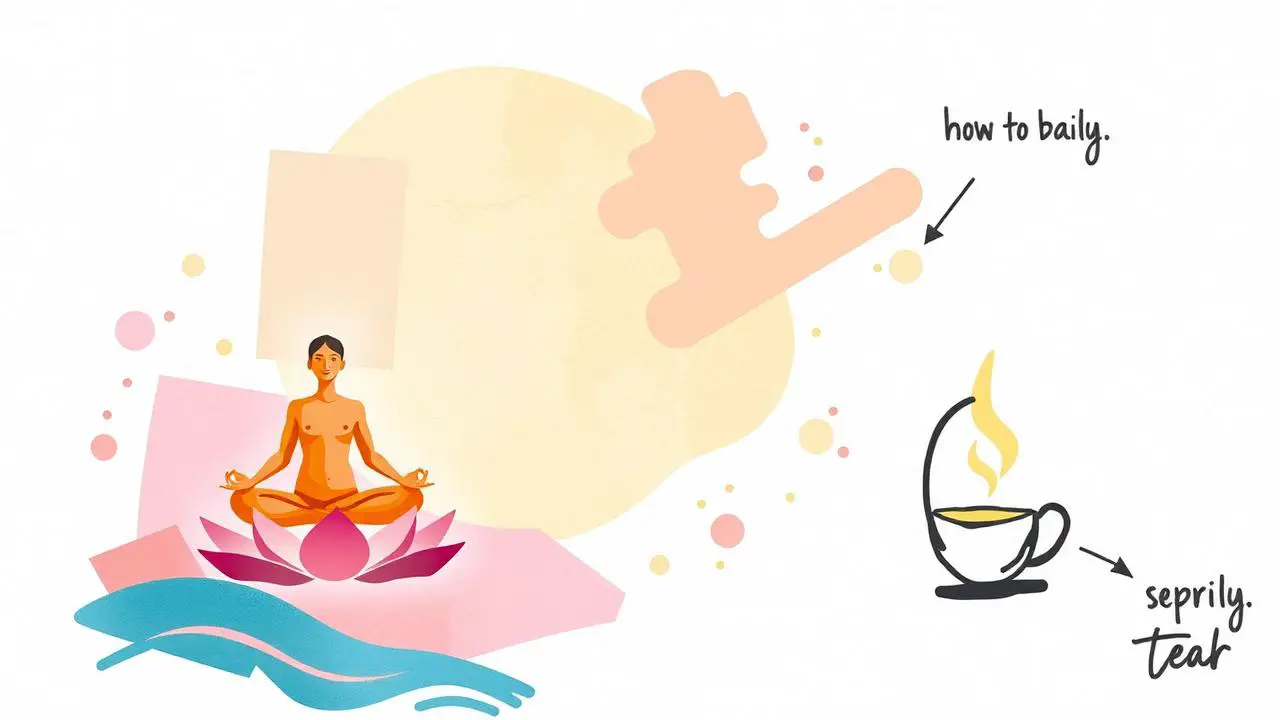Practicing mindfulness daily can be easy with a few simple steps. Start your morning with a mindful wakeup; sit comfortably, take deep breaths, and set positive intentions for the day. Before meals, remember to breathe and check how hungry you feel. While eating, savor each bite and listen to your body’s signals. Throughout the day, create gentle reminders to pause and check in on yourself. Engage fully in movement activities like yoga or walking by focusing on your breath. Journaling can help express emotions non-judgmentally. Lastly, stay consistent but accept that mindfulness is a journey, not perfection!
1. Mindful Wakeup: Setting Daily Intentions
Starting your day mindfully can set a positive tone for everything that follows. When you wake up, take a moment to sit comfortably and focus on your breath. Inhale deeply and exhale slowly, allowing yourself to fully awaken. Once you feel present, consider what your intentions are for the day. Ask yourself, “How do I want to show up today?” This could be about embracing kindness, being productive, or nurturing your creativity. You can also use prompts like, “What do I need to take better care of myself?” These questions help you clarify your goals and remind you of the qualities you wish to cultivate. Setting intentions in this way not only grounds you but also helps you stay focused throughout your busy day.
2. Mindful Eating: Savoring Every Bite
Mindful eating is all about being present while you eat, allowing you to truly experience your food. Start by taking a moment to breathe before you begin your meal. This simple act helps you check in with your hunger levels. Ask yourself, “How hungry am I on a scale of 1 to 10?” This awareness can guide you in choosing the right portion size and prevent overeating.
Once you begin eating, slow down. Instead of rushing through your meal, focus on the flavors and textures of each bite. Notice the crunch of a fresh vegetable or the creaminess of a sauce. By savoring each mouthful, you not only enhance your enjoyment but also give your body time to signal when it’s full. A helpful tip is to put your utensils down between bites, which naturally encourages you to eat more slowly.
Another key aspect of mindful eating is recognizing when you no longer enjoy the food. Sometimes we eat out of habit rather than hunger. By tuning into your body and understanding your preferences, you can make healthier choices and feel more satisfied. For instance, if you notice that you’re no longer enjoying the taste of a dish, consider stopping and saving the rest for later instead of finishing it just because it’s on your plate.
Incorporating mindful eating into your daily routine can transform your relationship with food, leading to greater satisfaction and well-being.
3. Mindful Pause: Creating Check-In Reminders
To cultivate mindfulness throughout your day, it’s essential to create reminders that prompt you to check in with yourself. These mindful pauses can be integrated seamlessly into your daily routine. Start by designing simple cues that will catch your attention, such as placing your meditation cushion in a visible spot or setting a specific time on your phone to remind you to take a moment for yourself. For instance, you might set a reminder every hour to pause, take a few deep breaths, and assess how you’re feeling at that moment.
To keep your practice fresh and engaging, consider changing your reminders regularly. If you always use the same sound for your alerts, you might stop noticing them over time. Instead, try switching up the tone or the time of day when you check in with yourself. This could be during a coffee break or when waiting in line. The goal is to create a habit of being present, allowing you to reconnect with your thoughts and emotions throughout the day.
4. Mindful Movement: Engaging with Awareness
Mindful movement encourages you to connect with your body and surroundings through physical activities. Whether it’s yoga, tai chi, or simply walking, approach these movements with intention. Focus on your breath and the sensations throughout your body as you engage in the activity. For example, during a yoga session, pay attention to how your muscles feel as you stretch and hold each pose. You might ask yourself, “What does my body need today?” This practice not only enhances your physical health but also cultivates a deeper awareness of your body’s capabilities and limitations. Additionally, set clear intentions before exercising. Instead of just going through the motions, remind yourself why you are moving—whether it’s to build strength, improve flexibility, or relieve stress. This mindset shift transforms exercise into a mindful practice, making it more fulfilling and connected to your overall well-being.
5. Mindful Driving: Finding Calm on the Road
Driving can often feel stressful and chaotic, but it also presents a unique opportunity for mindfulness. To cultivate a calm mindset on the road, start by taking deep breaths before you set off. This simple act helps center your thoughts and prepares you for the journey ahead. As you drive, pay attention to the sensations of your body—the grip of the steering wheel, the pressure of the seat against your back—allowing yourself to fully engage with the experience of driving.
When you encounter red lights or traffic jams, use these moments as a chance to pause. Instead of feeling frustrated, take a few deep breaths and check in with yourself. Ask, “How am I feeling right now?” This reflection can help you release tension and cultivate a sense of calm. You might also practice compassionate awareness by recognizing that other drivers share your desire for a smooth and safe journey. This perspective can shift your focus from irritation to empathy, enhancing your overall driving experience.
If you find your mind wandering to worries or distractions, gently redirect your focus to the present moment. Notice the sounds of the car, the rhythm of your breath, or even the scenery outside the window. By bringing your awareness back to the act of driving, you can transform a mundane task into a mindful practice that promotes relaxation and clarity.
6. Daily Mindfulness Practices: Incorporating Meditation
Incorporating meditation into your daily routine can significantly enhance your mindfulness practice. One effective way to start is by using guided meditations. Apps like Headspace or Calm provide short sessions that can fit into your busy day, making it easier to engage with meditation regularly.
Another practice to try is the body scan meditation. Set aside 10-15 minutes to lie down or sit comfortably. Focus on each part of your body, starting from your toes and moving up to the crown of your head. This practice helps to release tension and cultivate a deeper awareness of bodily sensations.
Additionally, consider scheduling regular check-ins with yourself throughout the day. Take a moment to pause, close your eyes, and take a few deep breaths. Notice any areas of tension in your body and use your breath to relax those areas. This simple practice can ground you and bring you back to the present moment, no matter how busy your day gets.
- Start with just a few minutes of meditation each morning.
- Find a quiet space where you can sit comfortably.
- Focus on your breath, inhaling deeply and exhaling slowly.
- Use guided meditations or meditation apps to help you get started.
- Experiment with different techniques such as mindfulness, loving-kindness, or body scan.
- Consider incorporating mindfulness into your meditation practices.
- Set an intention for your meditation session before you begin.
- Keep a meditation journal to track your progress and feelings.
7. Mindful Journaling: Expressing Thoughts and Emotions
Mindful journaling is a powerful tool for expressing thoughts and emotions. By taking the time to write, you can explore your feelings in a non-judgmental way. Start by finding a quiet space where you can focus. Begin with a few deep breaths to center yourself, then let your thoughts flow onto the page. You might want to describe your day, reflect on your feelings, or even jot down sensory details from your surroundings. For instance, you could write about the warmth of the sun on your skin or the sound of leaves rustling in the wind.
In addition to free writing, consider incorporating positive affirmations into your journaling routine. Affirmations like “I am enough” or “I am capable of handling whatever comes my way” can help counter negative thoughts and reinforce a positive mindset. Write these affirmations at the beginning or end of your journaling session to set a tone of self-acceptance and encouragement.
Another approach is to use prompts that guide your writing. For example, ask yourself questions such as “What am I grateful for today?” or “What challenges did I face, and how did I overcome them?” These prompts can help you delve deeper into your emotions and experiences, fostering a greater understanding of yourself. Over time, you’ll find that mindful journaling not only enhances your emotional awareness but also serves as a therapeutic outlet for stress and anxiety.
8. Engaging in Daily Activities: Mindfulness in Chores
Mindfulness can transform even the most mundane tasks into opportunities for awareness and presence. When you find yourself doing chores, such as washing dishes or folding laundry, focus your attention on the activity at hand. Notice the water’s temperature as you wash, the texture of the dishcloth, or the sound of clothes tumbling in the dryer. By immersing yourself in these sensations, you can turn routine tasks into moments of mindfulness.
For example, while sweeping the floor, pay attention to the rhythm of the broom against the ground and the movement of your body. Feel the muscles in your arms and legs as you engage in the task. This practice not only brings mindfulness into your daily life but also helps you to appreciate the act of cleaning as a form of self-care.
Additionally, consider engaging your senses further by integrating music or nature sounds while you work. This can enhance your experience, making chores feel less like a chore and more like a mindful practice. By shifting your perspective, you can cultivate a sense of peace and presence in every activity you undertake.
9. Mindfulness Tools: Apps and Reminders
Incorporating mindfulness into your daily life can be made easier with the help of various tools and resources. Mindfulness apps like Headspace or Calm offer structured practices that guide you through meditation, breathing exercises, and mindfulness techniques. These apps often include reminders that can prompt you to take a moment for yourself throughout the day. For instance, setting a reminder on your phone to pause and breathe can serve as a gentle nudge to check in with your thoughts and feelings.
You can also create physical reminders in your environment. This could be as simple as placing a sticky note on your bathroom mirror or using an app to send you notifications. The key is to find what works for you and to keep these reminders fresh. Regularly changing the time or content of your reminders can help maintain your engagement with mindfulness practices. By utilizing these tools, you can seamlessly integrate mindfulness into your routine, making it a natural part of your day.
| Tool/App | Features | Benefits |
|---|---|---|
| Headspace | Guided meditations, Sleep sounds, Mindfulness courses | Improves focus, Reduces stress |
| Calm | Meditation, Sleep stories, Relaxation music | Enhances sleep quality, Promotes relaxation |
| Insight Timer | Large library of guided meditations, Courses | Offers community support, Encourages daily practice |
| Breathe | Breath control techniques, Timer for breathing exercises | Reduces anxiety, Increases awareness |
| Smiling Mind | Programs for different age groups, Mindfulness techniques | Improves mental health, Provides age-relevant practices |
10. Avoiding Pitfalls: Embracing Your Journey
Mindfulness is a personal journey, and it’s essential to approach it with a non-judgmental attitude. Comparing your practice to others can lead to frustration and self-doubt. Instead, focus on your unique experience and progress. For instance, if you notice your mind wandering during meditation, gently bring your attention back without criticism. Rather than striving for perfection, aim for consistency. It’s normal to have days when your practice feels more challenging than others. Embrace these fluctuations as part of the learning process. Celebrate small victories, like successfully noticing when your mind drifts, as these moments are steps toward growth. Remember, mindfulness is not about achieving a specific state; it’s about being present with whatever arises.
11. Promoting Mindfulness: Seeking New Experiences
Seeking new experiences is a powerful way to promote mindfulness in daily life. When you step out of your comfort zone, you awaken your senses and engage with the present moment more fully. Try visiting a new park, taking a different route to work, or signing up for a class in something unfamiliar to you, like pottery or dance. Each of these activities can heighten your awareness and bring freshness to your routine.
For example, if you explore a new hiking trail, pay attention to the sights, sounds, and smells around you. Notice the feel of the ground under your feet and the wind on your face. Engage with your surroundings by observing the colors of the leaves, the patterns in the rocks, and the sounds of birds. This kind of immersion in new experiences can help you cultivate a mindful attitude.
Additionally, creating a calm space dedicated to your mindfulness practice can enhance this experience. Designate a corner in your home with comfortable seating, soft lighting, and plants. By associating this space with calmness and mindfulness, you reinforce the habits of awareness and presence every time you enter it.
12. Mindful Transitions: Noticing Sensory Changes
Mindful transitions involve paying attention to the sensory experiences that arise as you move from one environment to another. For example, when you step outside from a warm building, notice the cool air on your skin and the sounds of nature surrounding you. Similarly, as you enter a cozy room, recognize the shift in temperature, the different lighting, and even the scents that greet you. Taking a moment to acknowledge these changes can ground you in the present moment and enhance your mindfulness practice. You can also practice this during daily routines, such as moving from your workspace to the kitchen. As you transition, focus on the feel of the floor beneath your feet, the colors of the walls, and the sounds in the background. Engaging your senses in these transitions helps cultivate awareness and appreciation for the world around you.
Frequently Asked Questions
1. What is mindfulness and why should I practice it every day?
Mindfulness means being fully present and aware of what’s happening right now. Practicing it daily can help reduce stress, improve focus, and enhance overall well-being.
2. How can I start practicing mindfulness in my daily routine?
You can start by setting aside just a few minutes each day to focus on your breathing or observe your surroundings without judgment.
3. Are there specific techniques I can use to be more mindful during the day?
Yes! Techniques include deep breathing, mindful walking, and paying attention to your senses while eating or doing chores.
4. How do I stay consistent with my mindfulness practice?
Establishing a routine, setting reminders, or joining a mindfulness group can help you stay committed.
5. Can mindfulness help with anxiety and stress management?
Absolutely! Regular mindfulness practice can reduce anxiety and help you manage stress by promoting a calm and focused mind.
TL;DR To practice mindfulness daily, start with mindful waking by setting intentions for the day. Savor your meals through mindful eating, and create reminders for mindful pauses throughout your day. Engage in mindful movement during exercise, maintain calm while driving, and incorporate daily meditation practices. Use journaling to express emotions and practice mindfulness in everyday chores. Utilize mindfulness apps and set consistent reminders. Embrace the journey without judgment, seek new experiences, and be aware of sensory changes during transitions. These practices will enhance your mental well-being and focus.





12 responses to “How to Practice Mindfulness Daily”
so, anyone else finds mindful eating kinda hard? how do you guys stop from just scarfing down your meal lol? draperm, tips appreciated.
right? I start eating mindfully and then, bam, food’s all gone. guess we just gotta practice more
Mindful movement is where its at! never thought about how running could be zen. draperm, your article opened a new door for me, cheers!
mindful driving, huh? does that work when someone cuts you off and you’re late? curious if draperm ever tried that out.
Love love love mindful journaling. It’s really changed how I process my day. draperm, thanks for spreading the word!
Curious about these mindfulness apps. Are they really effective, or just another notification to ignore? Draperm, got any favorites?
mindfulness in chores, that’s a new one. tried it washing dishes and lost in my bubbles. does vacuuming count?
Avoiding pitfalls sounds fancy, but come on, how many actually stick with this stuff? Bet it’s just a phase for most.
Just starting out with all this. Anybody got easy tips for a beginner? Kinda overwhelmed here.
Hang in there, Nate. Start small, maybe with mindful wakeup? Sets a great tone for the day. You got this!
Mindful transitions and noticing sensory changes is fascinating to me. It’s like discovering a new dimension of life. Anyone else find this as intriguing?
can mindfulness really help with anxiety? feels like i’ve tried everything and still a mess. anybody got success stories?